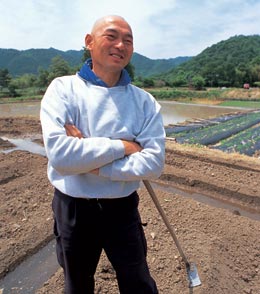|
Special Feature*
Life Is an Art in Kyoto— 3
Written by Torikai Shin-ichi
Photos by Kono Toshihiko
A Farmer's
Ambition: Kyo Vegetables for Everyday Meals
Tazuru Hitoshi
Vegetable farmer
|
 |
Tazuru Hitoshi cultivates kyo vegetables in northern Kyoto, in the Kamigamo district. The fields have been in his family for generations.
|
|
Tazuru Hitoshi grows kyo vegetables in Kyoto's Kamigamo district. He supplies them to the city's most popular restaurant serving the type of meals eaten for centuries in the old capital. Customers know they can depend on the high quality of his produce.
Kyo vegetables have been harvested in the Kyoto region since ancient times, and the local cuisine would not be the same without them. They are somewhat different in both taste and shape, and people look twice when they see them—for example, the eggplants are almost completely round, and the squash are not round at all, being shaped like gourds. They are also slightly larger than the ordinary varieties.
The region's farmers have selected their own seeds over the last 1,200 years, and this explains why kyo vegetables are different from ordinary varieties. After the national capital was moved to Kyoto in 794, vegetables from all over the realm were sent as gifts honoring the Court. Some seeds were saved and planted, and the ones most suitable for local growing conditions and tastes were selected for future plantings. This process of selection and elimination led to improved varieties and distinctive cultivation methods, passed down from generation to generation.
Tazuru says that his ancestors were also part of this process. "That's why, ever since I was young, I've wanted to help keep the traditions alive."
After graduating from an agricultural high school, he began helping out on the family farm. It was around then that more and more farmers started growing ordinary vegetables, like cabbage and tomato, rather than the kyo varieties.
"In those days we could make more money growing ordinary eggplants, rather than the traditional kamo variety."
He felt that kyo vegetables would become extinct if no one did anything about it. So he joined forces with six other young farmers and founded the Kyoto Traditional Vegetables Society. That was a good 20 years ago. They began with seeds from plants passed down within their families over the generations, and collected other seeds from old farming families they heard about.
"Today, I grow about 20 different types of kyo vegetables. One of them, the tanaka pepper, is not spicy. It's an ancestor of the sweet pepper."
Tazuru's fields measure one hectare in area. He starts work by 5 in the morning and keeps at it until dark. "Kyo vegetables are seen as a kind of luxury item, but hopefully one day they will be eaten as part of the everyday diet. That's why I sell them when they taste the best, and as cheaply as I can."
A few years ago, he began fertilizing his soil with composted waste food from supermarkets. He is also developing new recipes for his produce. All of his work with kyo vegetables shows how keen he is that more people eat them. 
|